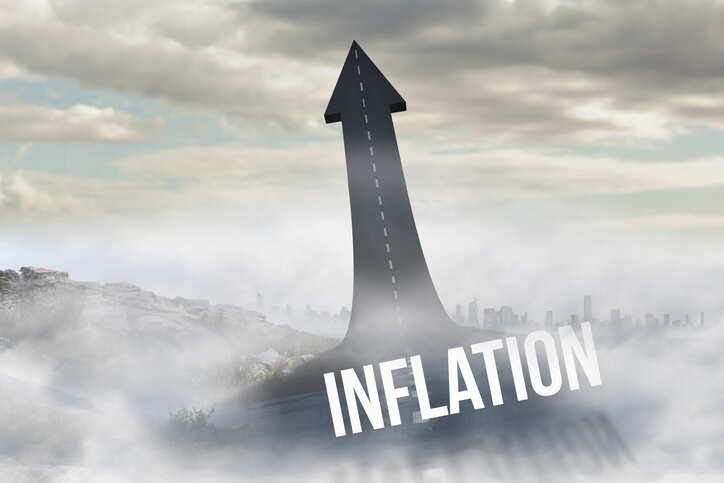
A widespread debate has raged on inflation for quite a while now. Many observers are concerned about a rise in inflation and believe that this will persist and lead to massive central bank action. The consensus is about an episode of runaway inflation. I don’t think it’s happening. The odds are low, drivers absent and a lot needs to change for this supply shock inflation to turn into a demand-led spiral.
Inflation is neither transitory, nor permanent. It’s cyclical.
Let me tell you why.
Inflation, especially in the developed world, has been on a declining path. Since 1990, the trend has been particularly more ‘dis-inflationary’ than otherwise.
There are disinflationary factors at play. Trends in commodity prices, which describe headline inflation trends, is the first one. The changes in commodity prices reflect the cyclical component while the core inflation is the structural component of price rise. Commodity prices have contributed to inflation, causing phases of discomfort for policy makers. But they have been anchored for decades now.
At this time the commodity price index is at a level similar to that in 1978. Accounting for rise in disposable income and change in the consumption basket, this trend is dis-inflationary for headline inflation. Commodities are a cyclical play, not structural. The cure for higher commodity prices is ‘higher commodity prices’.
Second factor is inflation targeting adoption by central banks. In this framework, a central bank estimates and makes public a projected, or “target”, inflation rate and then attempts to steer actual inflation towards that target, using tools such as interest rate changes.
By using inflation targeting central banks slowed the incremental pace of second level effects of cyclical inflation on wages and salaries. By raising the cost of borrowing and transmitting it through the financial system, central banks opted for slower and longer business cycles than for many short volatile ones.
A negative demand shock is the third factor. Demand has been structurally weak with the savings rate rising at a faster pace than the rate of investment. This feature repeats in a number of economies where inflation peaks and trends lower. Higher capacities created in boom periods allow for lower inflation trajectory even when demand is running near or above long-term trends at an aggregate level.
Most global economies have been and are in negative demand shock with savings rate rising faster than investments. This trend has accelerated now. World’s biggest economies like the US, EU and even China are now following this trend. This is a blind spot that people are missing.
A positive supply shock is the fourth key disinflationary trend. Several countries have been grappling not only with slow productivity growth but have also experienced a slowdown in real average wage growth relative to productivity growth, which has been reflected in a falling share of wages in GDP.
This has resulted in rapid decline in wage earners bargaining power leading to decoupling of wage growth and productivity. This means that even when there is growth, wages don’t rise as fast as volumes. This itself is a disinflationary spiral.
Businesses across sectors have undergone what I call ‘uberization’. The ‘Uberization’ of sectors means lower entry barriers for sellers, emergence of superstar firms which cut prices to compete and lower requirements for investments. This creates a circle for lower prices ahead. In addition, prices for goods have become significantly more uniform across retailers in the last decade.
Digitalization, pandemic-induced work from home trends and emergence of more avenues to work from anywhere has increased the possibility of technology driving ‘Uberization’ of more sectors and trends. That would leave another headwind for structural inflation to tackle.
An ageing population is another key headwind for inflationists. The demographic drag on growth and inflation is here to stay as a headwind. Higher dependency ratios combined with technological advancements causes prices to fall for core inflationary goods.
Some of the trends accelerated by COVID like high levels of savings, negative interest rates and work from home trends support lower demand, higher productivity, and lesser incremental needs of incremental capex. These factors are disinflationary.
The high prints of inflation that you are witnessing across the world are very normal and, in fact, a feature of most post-recession recoveries. Key drivers that contribute to this trend are a fall in commodity prices at the beginning of recession and the rapid recovery which sets in during the bottoming of the business cycle.
In case of recessions where supply chains are hit, like the COVID-induced pandemic, the wholesale prices and input prices cause a spectacular rise in inflation. These fast-moving price trends are painful adjustments which are more often intermediate in nature. As supply bottlenecks ease, prices mean revert. Base effects cause these readings to look appallingly large but they are normal and recurring across cycles.
Can post-recession inflation turn from a cyclical trend to a structural rise in prices?
The short answer is no. The structural threat of inflation could be real in case the escalation in prices is passed on into higher employment combined with higher wages and salaries. In most post- recession recoveries, it takes years to revert to pre-recession wages growth rates. Combine this with our earlier argument on productivity gains, the net impact of post-recession recoveries have been more deflationary than inflationary.
The current post-COVID recovery has an added vector of accelerating the more productive, lower cost and lesser investment expenditure cycle. This, in itself, provides credible headwinds to inflationary argument on a sustained level. In conclusion, don’t get blindsided by the inflationary narrative. It could be a bogey.
(Sahil Kapoor is Head- Products and Market Strategy, DSP Investment Managers. Views are his own)